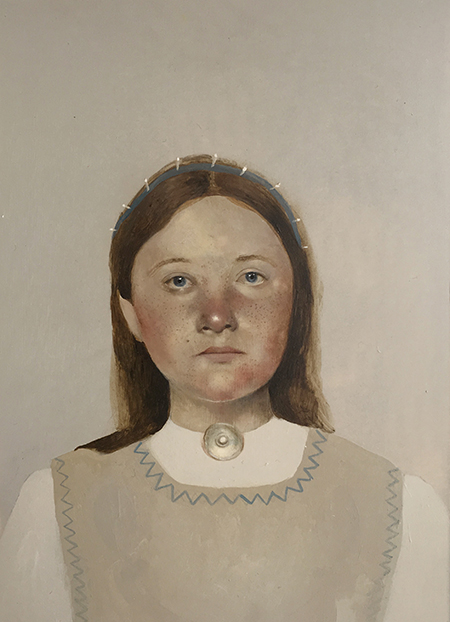
Continuing through May 13, 2017
Sarah Ball’s intimate paintings were first seen a little over two years ago in a successful introduction. Thus established, the current pieces from two distinct bodies of work are given plenty of room to breathe, and they reveal the point that artists of proven talent do actually keep getting better. “Kindred,” the title of the current exhibition, is drawn from two photographic archives: images captured at Ellis Island and published in 2005 as "Augustus F. Sherman: Ellis island Portraits 1905-1920," and the so-called “Romanian" images, a large cache of newly rediscovered photographs by the largely unknown photographer Costica Acsinte, who was active in Romania from 1925 to 1984.
These decades-old documentary style photographs inspired Ball's “Immigrants" series, which includes both small-scale paintings and drawings. As a whole the works of art in “Kindred" firmly take hold of current events and set their sights on immigration and international policies concerning migrants and those rendered stateless by catastrophic events motivated by a politics derived from racial and religious persecution. Ball, a British citizen, sees her work as a commentary on what motivated the disastrous Brexit vote in her country as well as the similarly foreboding turn toward the right in the U.S.
Sherman was an Ellis Island registry clerk who, untrained as a photographer, documented new arrivals to America from a wide range of backgrounds who were detained for medical reasons or further interrogation. Conversely, Acsinte was a trained photographer who operated a commercial studio that documented people and families as they lived their lives. After WW II the country was essentially closed to the West behind the iron curtain. Romania was mostly a rural nation. When forced collectivism became policy it tore apart traditional community and cultural networks, and Acsinte’s images bear witness to these lost people who became displaced migrant-like prisoners in their own country.
Ball co-mingles these two narrative threads with an aesthetic proposition that seizes upon archival documentary photography as source imagery for paintings that are contemporary translations of the originals. Through her particular style and the addition of color, the artist raises the narrative level and overall content present in these works of art beyond that of the source material. The figures become more real through the use of oil paint on gessoed panel, a kind of debunking of the position that the purpose of photography relates to a direct correspondence with objective reality, record keeping and memory formation. Ball’s subjects are identified by the series they belong to and to where they come from, if known, in a small scale format around 7 by 5 inches, with titles like "Immigrant Series Laplander," “Indian," “Romanian," “French" and so on. They are all presented from head to torso against a bare light grey background, cut off at the bottom edge and fully rendered toward the top, adhering to the format of the original image. Where there may have originally been some depth and perspectival space conferred by the camera lens, Ball masterfully depicts them as extremely flat.
These intriguing figures superimposed over the evacuated space beg comparisons to the New Objectivity aesthetic of the 1920’s or to Byzantine iconography (flatness) and the early Renaissance master Cimabue. In almost every one of Ball's images the people stare out directly at the viewer, who is unable to sever their gaze no matter where they position themselves, exactly like the saints in religious icons who are said to picture the world in 360 degrees, expressive of divine omniscience. This functions to retrieve the subjectivity of the sitter and humanize the images in the photographs. Also, the effect is heightened by the strong naturalism the artist uses to depict the sitters, their facial features, and their clothes, often dressed in the cultural garb specific to where they came from. Ball’s signature picture framing combined with her use of naturalism, complete with glazing and other techniques, invigorates and modernizes these lost people, identifying the viewer with them as historical figures, as well as foregrounding the opening of an invitation to consider the plight of millions of people like them, displaced and vulnerable in the contemporary world.
